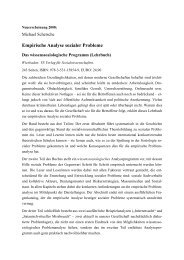Psychophysiology of False Memories in a Deese-Roediger ... - IGPP
Psychophysiology of False Memories in a Deese-Roediger ... - IGPP
Psychophysiology of False Memories in a Deese-Roediger ... - IGPP
Create successful ePaper yourself
Turn your PDF publications into a flip-book with our unique Google optimized e-Paper software.
<strong>Psychophysiology</strong> <strong>of</strong> Visual <strong>False</strong> <strong>Memories</strong><br />
sites <strong>of</strong> the non-dom<strong>in</strong>ant hand. For registration <strong>of</strong> abdom<strong>in</strong>al and<br />
thoracic respiratory activity, two PS-2 bi<strong>of</strong>eedback respiration<br />
sensor belts (KarmaMatters, Berkeley, California) with built-<strong>in</strong><br />
length-dependent electrical resistances were used. The belts were<br />
fixed over clothes at the level <strong>of</strong> the lower thoracic aperture and<br />
the umbilicus, respectively. Electrocardiogram was measured with<br />
Hellige electrodes (diameter 1.3 cm) accord<strong>in</strong>g to E<strong>in</strong>thoven II.<br />
F<strong>in</strong>ger pulse signal was transmitted by an <strong>in</strong>frared system <strong>in</strong> a cuff<br />
around the middle f<strong>in</strong>ger <strong>of</strong> the non-dom<strong>in</strong>ant hand.<br />
Behavioral measures<br />
1) Study phase: Behavioral data from the study phase were not<br />
analyzed.<br />
2) Recognition phase: After a delay <strong>of</strong> six seconds between<br />
question and prompt to answer, subjects responded with<br />
‘‘yes’’ or ‘‘no’’ by press<strong>in</strong>g a key. Answers were stored on the<br />
stimulus-present<strong>in</strong>g computer for later evaluation <strong>of</strong> error<br />
rates. The delay was used to prevent confound<strong>in</strong>g orient<strong>in</strong>grelated<br />
with motor-related electrodermal responses. Because<br />
<strong>of</strong> the delayed answer<strong>in</strong>g, reaction times were discarded from<br />
evaluation.<br />
Data reduction<br />
Electrodermal reactions were assessed with a computerized<br />
method based on the decomposition <strong>of</strong> overlapp<strong>in</strong>g reactions as<br />
proposed by Lim et al. [57]. The algorithm was adopted from<br />
Ambach et al. [44]. The time w<strong>in</strong>dow used for the def<strong>in</strong>ition <strong>of</strong> the<br />
EDA response was def<strong>in</strong>ed as 0.5 to 4.5 seconds after item<br />
presentation <strong>in</strong> order to correspond with the first EDA component<br />
reported by Ambach et al. [44], which is assumed to reflect<br />
orient<strong>in</strong>g-related processes. EDA data from two subjects had to be<br />
discarded from analysis, because they met the criterion for hyporespond<strong>in</strong>g<br />
def<strong>in</strong>ed <strong>in</strong> this study (more than 90% non-responses).<br />
Respiratory data from both respiration belts were manually<br />
scanned and low-pass filtered <strong>in</strong> order to elim<strong>in</strong>ate artifacts. The<br />
total respiration l<strong>in</strong>e length was computed over a time <strong>in</strong>terval <strong>of</strong><br />
10 seconds after trial onset. The respiration l<strong>in</strong>e length measure<br />
<strong>in</strong>tegrates <strong>in</strong>formation about frequency and depth <strong>of</strong> respiration.<br />
The method was derived from Timm [58] and modified by<br />
Kircher and Rask<strong>in</strong> [59]. The respiration l<strong>in</strong>e length data from<br />
both belts were averaged.<br />
Electrocardiogram data were visually <strong>in</strong>spected, after notch<br />
filter<strong>in</strong>g at 50 Hz and an automatic R-wave peak detection. The<br />
R-R <strong>in</strong>tervals were transformed <strong>in</strong>to heart rate and real-time scaled<br />
[60]. Heart rate dur<strong>in</strong>g the last second before trial onset served as<br />
pre-stimulus basel<strong>in</strong>e. Phasic heart rate was calculated by subtract<strong>in</strong>g<br />
this value from each second-per-second poststimulus value. For<br />
extract<strong>in</strong>g the trial-wise <strong>in</strong>formation <strong>of</strong> the phasic heart rate, the<br />
mean change <strong>in</strong> heart rate with<strong>in</strong> 15 seconds after trial onset<br />
compared with the prestimulus basel<strong>in</strong>e, was calculated [61,62].<br />
F<strong>in</strong>ger pulse waveform length with<strong>in</strong> the first 10 seconds after<br />
trial onset was calculated from f<strong>in</strong>ger pulse waveform and subjected<br />
to further analyses [45]. The f<strong>in</strong>ger pulse waveform length<br />
comprises <strong>in</strong>formation about heart rate and pulse amplitude.<br />
Statistics<br />
Two <strong>in</strong>dependent variables determ<strong>in</strong>e the design <strong>of</strong> this study:<br />
the with<strong>in</strong>-subject factor ‘‘Item Type’’ (related lures/related<br />
controls, studied items, unrelated items) and the between-subjects<br />
factor ‘‘Group’’ (experimental group, control group). A third<br />
factor, the ‘‘Correctness <strong>of</strong> Response’’ (true, false) can only be<br />
determ<strong>in</strong>ed item-wise and post-hoc and thus has to be regarded as<br />
quasi-experimental. The hierarchical dependency <strong>of</strong> the data and<br />
the unequally balanced cells are major violations <strong>of</strong> the<br />
assumptions <strong>of</strong> the General L<strong>in</strong>ear Model. Regard<strong>in</strong>g these<br />
violations, all calculations <strong>of</strong> physiological data were made on<br />
basis <strong>of</strong> Hierarchical L<strong>in</strong>ear Model analyses. An additional advantage<br />
<strong>of</strong> the Hierarchical L<strong>in</strong>ear Model is that it is able to model<br />
<strong>in</strong>dividual basel<strong>in</strong>e differences <strong>in</strong> peripheral physiological data by<br />
<strong>in</strong>clud<strong>in</strong>g random <strong>in</strong>tercepts <strong>in</strong>to the model. This makes with<strong>in</strong>subject<br />
standardization, as proposed by Lykken and Venables<br />
[63], dispensable. Therefore, data were not averaged over trials;<br />
trials were treated as level 1 units <strong>of</strong> analysis and subjects as level 2<br />
units <strong>of</strong> analysis (aggregation variable). Maximum likelihood<br />
criteria were employed. ‘‘Unstructured’’ was used as the<br />
covariance structure, with 100 iterations be<strong>in</strong>g performed.<br />
Significance level for the assessment <strong>of</strong> ma<strong>in</strong> and <strong>in</strong>teraction<br />
effects was set to 0.05; trends are reported for results below 0.10.<br />
Statistical analyses <strong>of</strong> recognition judgments <strong>in</strong>clude x 2<br />
frequency tests to evaluate the frequency distributions across cells.<br />
Hereby, different expected values calculated on item presentation<br />
frequencies are be<strong>in</strong>g considered. A total <strong>of</strong> n<strong>in</strong>e miss<strong>in</strong>g trials (no<br />
answer) were removed.<br />
In a first step, direct comparisons <strong>of</strong> cells were calculated with<strong>in</strong><br />
the experimental group. Then, <strong>in</strong> order to consider possible<br />
systematic differences between item types, analyses <strong>of</strong> Group by<br />
Item Type <strong>in</strong>teraction effects were conducted; Item Type was<br />
restricted to the levels studied items and related lures/related<br />
controls only. Unrelated items were only used as a manipulation<br />
check to test for a possible bias <strong>in</strong> recognition; physiological data<br />
from these items were not analyzed. All statistical analyses were<br />
performed with PASW, Version 18.0.0 (SPSS Inc., Chicago).<br />
Results<br />
Recognition judgments<br />
Figure 2 summarizes response behavior <strong>in</strong> the recognition phase<br />
for both groups. In the experimental group, the proportion <strong>of</strong><br />
falsely recognized related lures was higher than the proportion <strong>of</strong><br />
falsely recognized unrelated items (x 2 [1, N = 587] = 114.41;<br />
p,0.001). In the control group, proportions <strong>of</strong> recognized related<br />
controls and studied items also differed significantly (x 2 [1,<br />
N = 1254] = 21.91; p,0.001).<br />
Sk<strong>in</strong> conductance<br />
Hierarchical L<strong>in</strong>ear Model analysis for EDA showed a trend<br />
towards smaller response amplitudes for falsely recognized<br />
related lures compared to correctly recognized studied items (F<br />
[1,714.44] = 2.86; p = 0.09) <strong>in</strong> the experimental group. The<br />
correspond<strong>in</strong>g analysis <strong>in</strong> the control group showed no effect (F<br />
[1,910.30] = 1.01; n.s.).<br />
The 262 Hierarchical L<strong>in</strong>ear Model analysis for EDA showed a<br />
significant Group by Item Type <strong>in</strong>teraction (F [1,1625.81] = 4.01;<br />
p = 0.045), confirm<strong>in</strong>g the observed differences between true and<br />
false recognition on between-group level.<br />
Respiration<br />
Respiration l<strong>in</strong>e length data showed lower values for falsely<br />
recognized related lures than recognized studied items <strong>in</strong> the<br />
experimental group (F [1,802.55] = 4.94; p = 0.027). In the control<br />
group, reactions differed analogously between recognized related<br />
controls and recognized studied items (F [1,909.16] = 5.085;<br />
p = 0.024). No Group by Item Type <strong>in</strong>teraction was found (F<br />
[1,1711.72] = 0.00; n.s.), <strong>in</strong>dicat<strong>in</strong>g that a difference between true<br />
and false recognition was not proven at the between-groups level.<br />
PLoS ONE | www.plosone.org 5 January 2012 | Volume 7 | Issue 1 | e30416


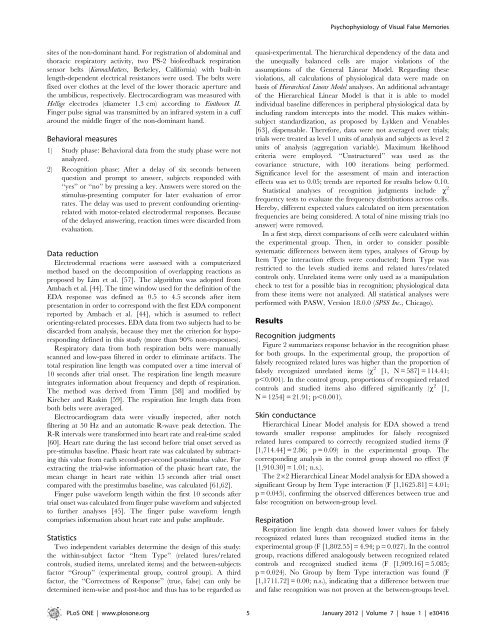
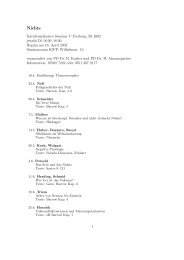
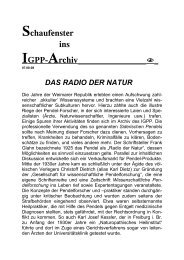
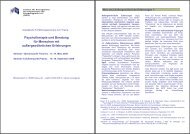
![Findliste Nachträge1 [pdf] - IGPP](https://img.yumpu.com/22552359/1/184x260/findliste-nachtrage1-pdf-igpp.jpg?quality=85)

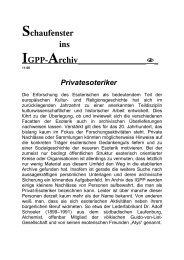
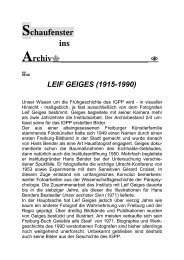
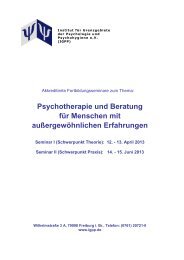
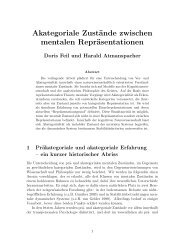
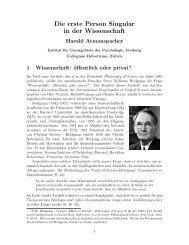
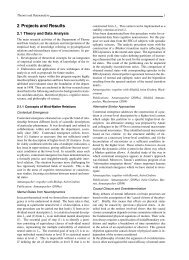
![Findliste [pdf] - IGPP](https://img.yumpu.com/22552265/1/190x245/findliste-pdf-igpp.jpg?quality=85)

